I think it really would be spring already, if the big weather systems would stop hurtling across the country and scaring it away. I’m going to berate everyone in states west of here for letting these hooligans get past them.
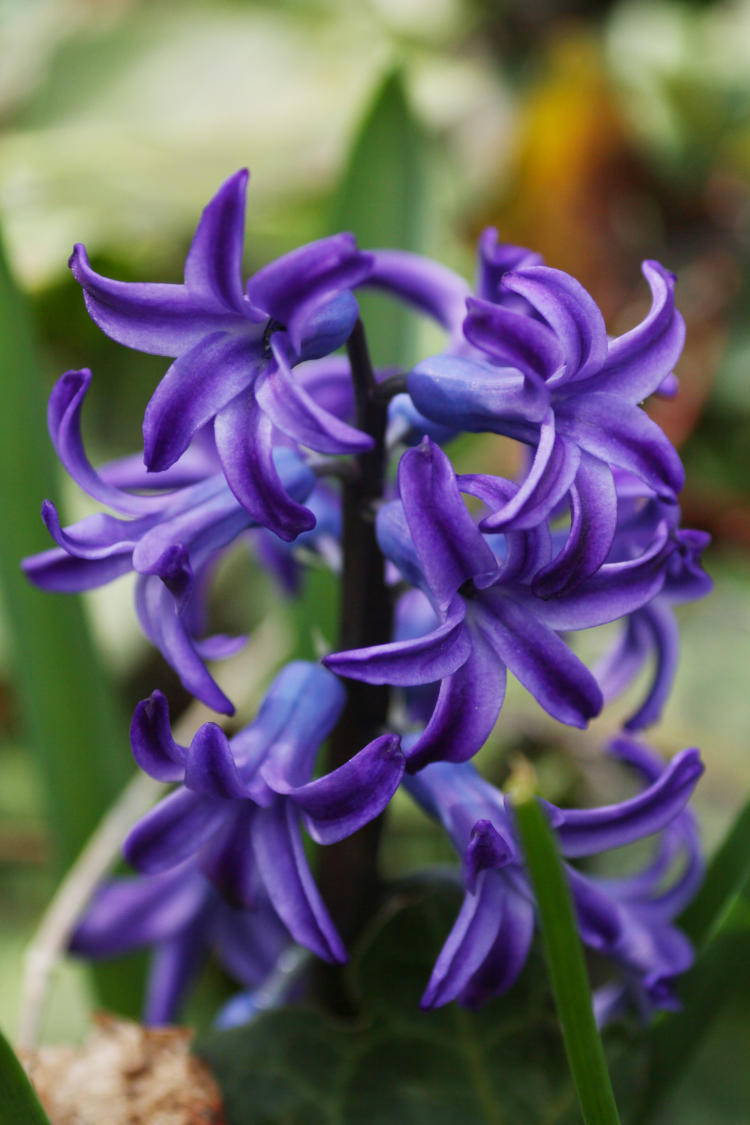
Yesterday the weather cleared and warmed again, and I did a small patrol of Walkabout Estates to see what was going on. I already knew the blue hyacinth flowers were coming up, having been a bit smarter than the pink by waiting for the freezing temperatures to pass. And a few branches of the rosemary bushes had been pushing out the occasional blossom for a few weeks now, though this one seems ready to do it proper very soon.

Abruptly, however, the Yoshino cherry tree was sporting the first flowers, apparently spurred by the heavy rains recently. The sky was clearing, so with a little awkward dancing I was able to get some blue in there, even when the flower itself was in the shade of the larger trees nearby.
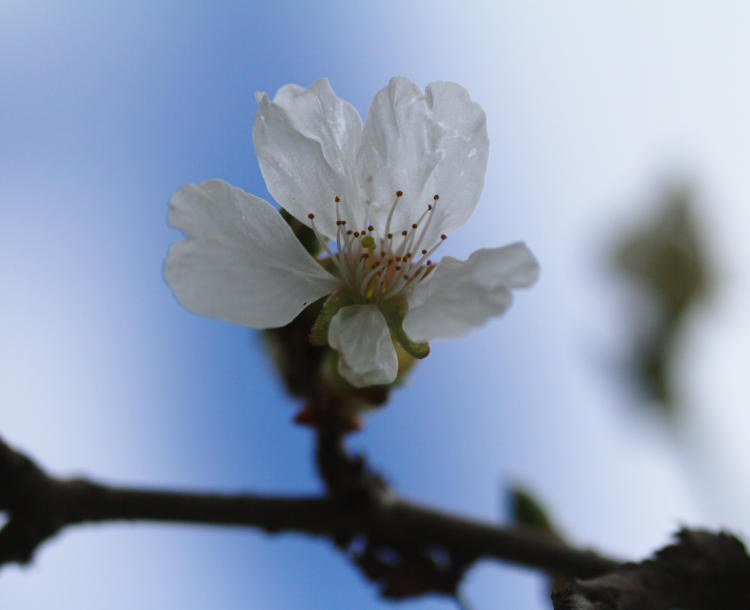
I say “awkward” above because the tree is only a little taller than I, and most of the blossoms sit at eye-level or lower, but aimed downwards for some evolutionary reason, so getting a ‘face-on’ perspective required half-kneeling and aiming upwards, and then scooting around to get a patch of blue for the background. Honestly, the efforts that this content requires – you should be honored.
And one of the itty-bitty maples out back was sporting some samaras, which made a little photogenic spot by itself.

It’s curious: the maple and the cherry trees throw out flowers first thing, long before any leaves appear, while the almond tree is well leafed out but probably won’t produce any flowers for a little while yet – judging from the two times past that it’s done so, it could happen any day or not for a couple weeks yet. Or not at all. Really, two blooming seasons totaling four flowers isn’t anything to make a baseline from.
But then there was the surprise.
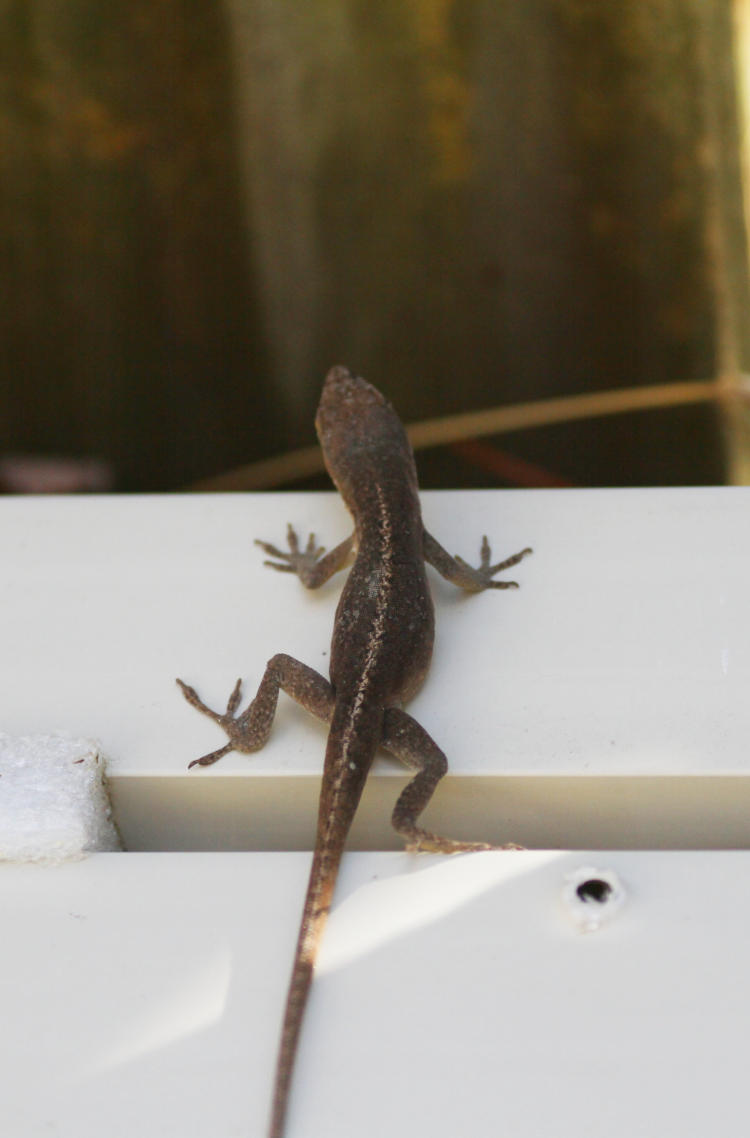
Out behind the shed, atop a stack of windows that had been replaced last year and we’re still trying to figure out what to do with, a smallish Carolina anole (Anolis carolinensis) attracted my attention. It was certainly warm enough today, though the nights have still been getting fairly nippy and I imagined that this guy would have waited a bit longer for dependably warm temperatures, but here we are. It was being just a little cautious and so getting a decent portrait remained beyond me yesterday, though I tried three separate times. But then, as The Girlfriend got home and I took her around to see the little spud, we found another, a large adult only a couple meters away.
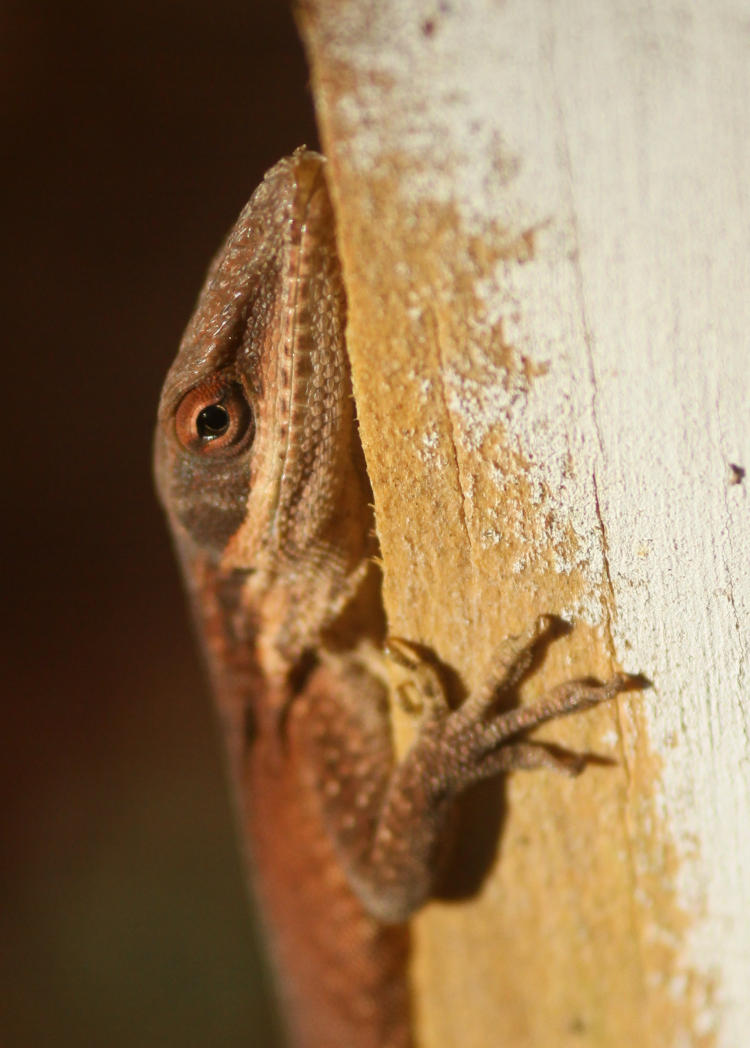
This one was on a couple of pieces of scrap plywood that we retain for projects, and settled itself into a camouflage position against the edge, so my careful approach allowed for a much closer portrait, helped by the bright afternoon sun.
As I was doing this, I was pondering their life cycles a little bit. I read that they only produce one egg at a time, unlike the various skinks in the area, and to the best of my knowledge they only have one birthing season though don’t quote me on that. So, two adults producing one offspring a year? That doesn’t make for impressive numbers, or even survivability, which likely means there’s more to the equation, either more birthing seasons throughout a calendar year, or males impregnating multiple females each season, or both. Many species have multiple offspring, either clutches of three to seven or so like the skinks, or a few dozen to hundred like the mantids, solely to combat attrition, the loss of offspring before they can reach reproductive age. One egg just seems all wrong, but again, me photographer, someone else herpetologist.
The same adult settled in immediately adjacent to its perch above once night fell, as I discovered when I went back out later on to see what the evening held.
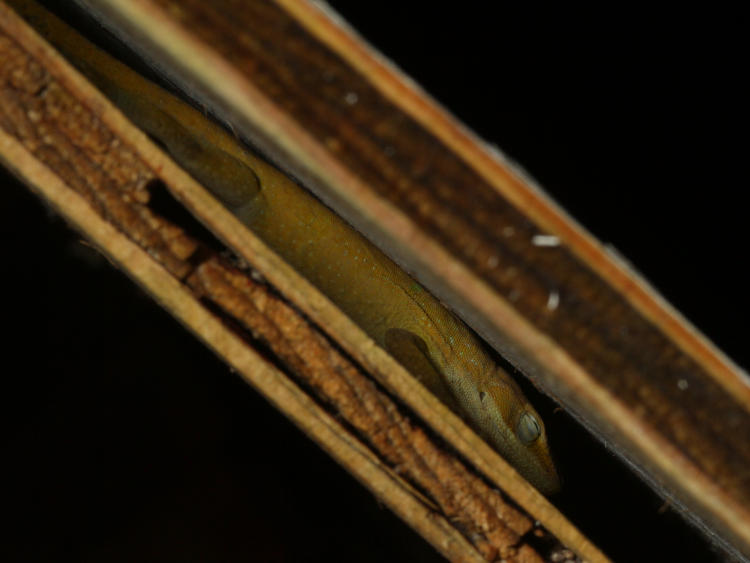
I never would have spotted this had I not been prompted to look from finding it nearby earlier, and I’m pleased that the flash got into the crack adequately – that’s why it’s at a diagonal. I was too lazy to readjust the flash arm to account for the position of the boards, so I just tilted the camera rig.
The greenhouse is right next to this, so I peeked in to see if there was activity, and there was.
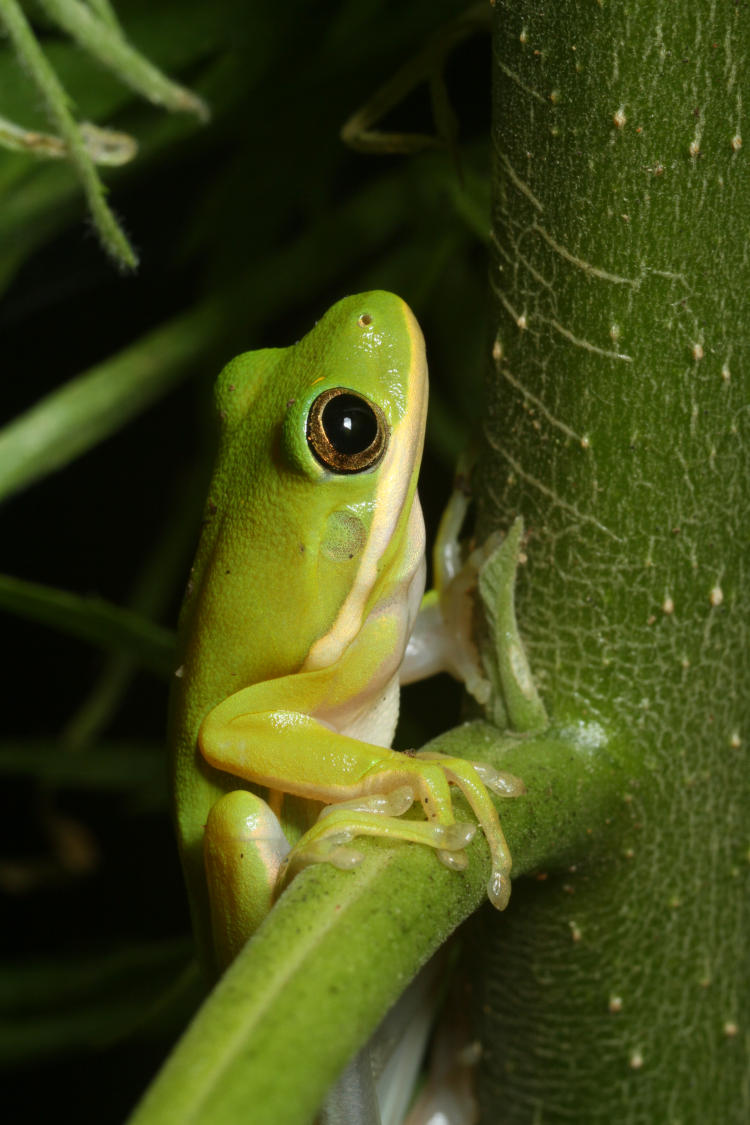
There’s no reason this image should be as clear as it is, because this juvenile green treefrog (Hyla cinerea) was tucked in among the voluminous leaves of one of the trumpet flowers (Brugmansia,) and getting a clear view was hard enough; I figured the flash head was going to be well blocked, but apparently not. This is not the one that I placed in there for its own safety a few days back, being much smaller; the foliage in there is so dense right now that a dozen or so could be perched within and I’d never see them without a major expedition. In a couple of weeks, most of the plants will move out into the yard, and I’ll try to ensure that the treefrogs go with them. And then, maybe we’ll get some tomatoes and basil established for year-round production.
Each year I treat the appearance of the treefrogs as the ‘official’ start of spring, which is better than some fixed date, though that frog above, being in the greenhouse, doesn’t count. This one does, though.
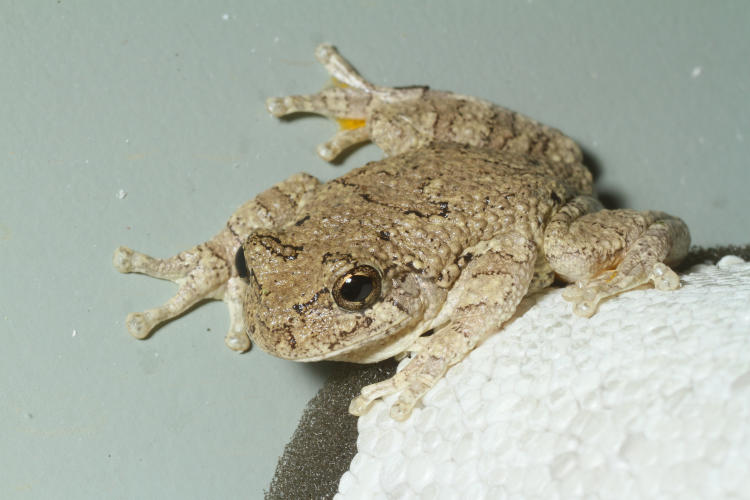
Over on the wall right alongside the frost cover for the water spigot, an adult Copes grey treefrog (Hyla chrysoscelis) sat evaluating the temperature, not quite warm enough to consider it mating season even while, somewhere in the distance, the chorus frogs were vocally proceeding with the event. While I’ve been trying to get more dynamic and fartsy with my photos, this one didn’t lend itself to any creative approaches at all, though I’ll Photoshop something up if you really want it (even though it’ll be with GIMP instead, but that doesn’t sound right as a verb.) Almost directly underneath it, a juvie green was perched on a grounding wire, but that was even worse.
So instead, I’ll close with the juvie green out front, peeking from the rain gutter under the roof overhang and looking intrepid, or something.
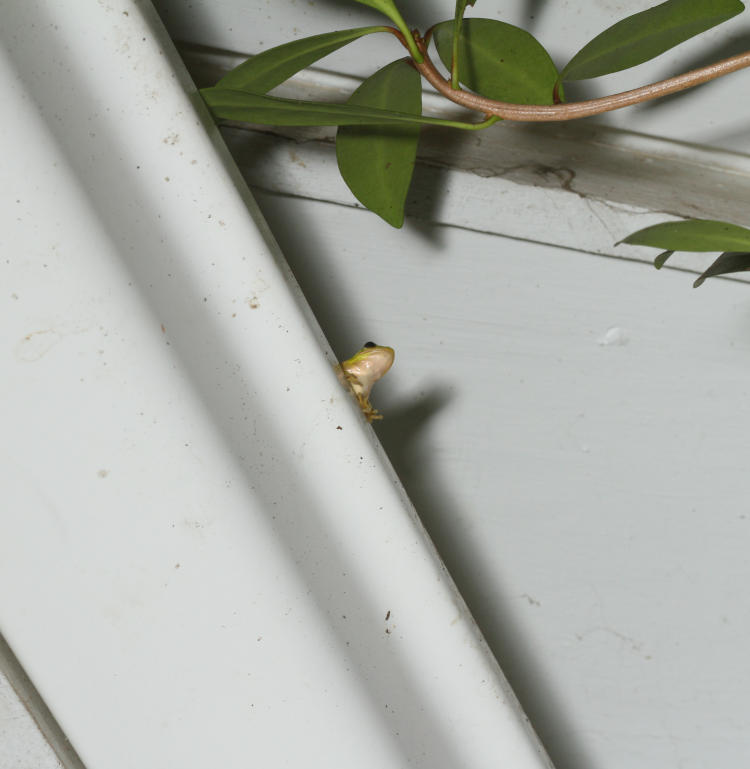
Why do we have rain gutters under the roof overhang? It’s hard to describe, but it makes perfect sense – not all of it is under the overhang, just a small portion where it connects to the downspout that runs along the wall. Seriously, we’re on it, okay? Just appreciate the noble crimefighting frog here.




















































